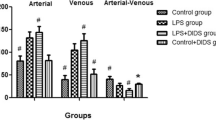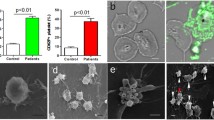Abstract
Pentoxifylline (PTX) has been shown to combat effectively endotoxin induced symptoms of shock or inflammation by reducing both leukocyte activation and endogenous cytokine formation. With regard to blood perfusion, inflammation is defined as a local reaction to injury of the living microvasculature and its content. Leukocyte margination, rolling, adhesion, and emigration is mediated by adhesion molecules along the endothelium of postcapillary venules and is considered to be an important step in the inflammatory response. Changes in the vascular integrity can be estimated in terms of increased extravasation of macromolecules. Using intravital microscopy with the help of an analogous video image processing system we measured the effect of PTX on lipopolysaccharide (LPS, 15 mg/kg i.v.) induced leukocyte adhesion and extravasation of FITC-rat serum albumin (FITC-RSA) in rat mesenteric venules. The changes in vascular permeability correlates significantly (r=0.75) with a locally increased number of adherent leukocytes. PTX significantly inhibits both leukocyte adhesion and extravasation of FITC-RSA dose dependently. Our results indicate that PTX effectively preserves vascular integrity in the microcirculation by acting primarily on LPS-induced leukocyte adhesion.
Similar content being viewed by others
References
Dutrochet MH. Recherches anatomiques et physiologiques sur la structure intimé des animaux et des regetaux, et sur la motilité. Baillié et Fils Paris 1824.
Cohnheim JF. Über Entzündung und Eiterung. Virchow's Arch 1867;40:1–97.
Harlan JM. Leukocyte-endothelial interaction. Blood 1985;65:513–25.
Hynes PO, Lander AD. Contact and specifities in the association, migrations, and targeting of cells and axons. Cell 1992;68:303–22.
Springer A. Adhesion receptors of the immune system. Nature 1990;346:425–34.
Smedegard G. Mediators of vascular permeability in inflammation. Prog Appl Microcirc 1985;7:96–112.
Björk J, Smedegard G, Svensjö E, Arfors KE. The use of the hamster check pouch for intravital microscopy studies of microvascular events. Prog Appl Microcirc 1984;Vol. 6:41–53.
Henderson B, Blake S. Therapeutic potential of cytokine manipulation. TIPS 1992;13:145–52.
Doukas J, Hechtman HB, Shepro D. Vasoactive amines and eicosanoids interactively regulate both polymorphonuclear leukocyte diapedesis and albumin permeability in vitro. Microvasc Res 1989;37:125–37.
Thomas PD, Hampson FW, Casale JM, Huntinghake GW. Neutrophil adherence to human endothelial cells. J Clin Med 1988;III:286–92.
Svensjö E, Erlansson M, van den Boss GC. Endotoxininduced increase in leukocyte adherence and macromolecular permeability of postcalillary venules. Agents Actions 1990;29:21–3.
Majno G, Gilmore V, Leventhal M. On the mechanism of vascular leakage caused by histamine-type mediators. Circ Res 1967;21:833–47.
Beutler B, Cerami A. The biology of cachetin/TNF: a primary mediator of the host response. Ann Rev Immunol 1991;7:625–55.
Fiers W. Tumor necrosis factor: characterisation at the molecular, cellular and in vivo level. FEBS Lett 1991;285:199–212.
Hawrylowicz CM. Viewpoint: a potential role for platelet derived cytokines in the inflammatory response. Platelets 1993;4:1–10.
Josaki K, Contrino J, Kristie J, Krause P, Kreutzer DK. Pentoxifylline-induced modulation of human leukocyte function in vitro. Am J Pathol 1990;136:623–30.
Waxman K. Pentoxifylline in septic shock. Crit Care Med 1990;18:243–4.
Atherton A, Born GVR. Quantitative investigations of the adhesiveness of circulating polymorphnuclear leukocytes to blood vessel walls. J Physiol 1972;222:447–74.
Atherton A, Born GVR. Relationship between the velocity of rolling granulocytes and that of the blood flow in venules. J Physiol 1973;233:157–65.
Grant L. The sticking and emigration of white blood cells in inflammation. In Zweifach BW, Grant L, McCluskey RT, editors. New York: Academic Press, 1973:205–49.
Fox JR, Wayland H. Interstitial diffusion of macromolecules in the rat mesentery. Microvasc Res 1979;18:255–76.
Laux V, Seiffge D. Mediator-induced changes in macromolecular permeability in the rat mesenteric microcirculation. Microvasc Res 1995;49:117–33.
Goto Y, Baez S, Orkin LR. The effect of endotoxin on microcirculatory and lymphatic dynamics in the rat (Schwartzman Phenomenon). Circ Shock 1981;8:533–42.
Brackett DJ, Schäfer CF, Tompkins P, Fragaius L, Peters LJ, Wilson MF. Evaluation of total peripheral vascular resistance, and plasma concentrations of vasopressin in the conscious, unrestrained rat during endotoxemia. Circ Shock 1985;17:273–84.
Mayrovitz HN, Wieldman MP, Tuma RF. Factors influencing leukocyte adherence in microvessels. Thrombos Haemostas 1977;38:823–30.
Wayland H, Johnson PC. Erythrocyte velocity measurement in microvessels by a two-slit photometric method. J Appl Physiol 1967;22:333–7.
Intaglietta M, Tompkins WR, Richardson DR. Velocity measurements in the microvasculature. Microvasc Res 1970;2:462–73.
Baker M, Wayland H. On-line volume flow rate and velocity profile measurement for blood in microvessels. Microvasc Res 1974;7:131–43.
Lipowsky HH, Kovalcheck S, Zweifach BW. The distribution of blood rheological parameters in the microvasculare of cat mesentery. Circ Res 1978;43:738–49.
Nazziola E, House SE. Effects of hydrodynamics and leukocyte endothelium specifity on leukocyte-endothelium interactions. Microvasc Res 1992;44:127–42.
Nourshargh S, Williams TJ. Mechanism of granulocyte-dependent oedema. In: Gordon L. editor. Vascular endothelium: interaction with circulating cells. Elsevier: Amsterdam 1991:161–74.
Wedmore CV, Williams TJ. Control of vascular permeability by polymorphonuclear leukocytes. Nature 1981;289:646–50.
Ward A, Clissold SP. Pentoxifylline. A review of its pharma-codynamic and pharmacokinetic properties, and its therapeutic efficacy. Drugs 1987;34:50–97.
Sullivan GW, Carper HT, Novick WJ, Mandell GJ. Inflammatory action of interleukin-1 and tumor necrosis factor (alpha) on neutrophil function by pentoxifylline. Infect Immun 1988;56:1722–9.
Wong PM, Schmid-Schönbein GW. Attenuation of spontaneous pseudopode formation in human neutrophils by pentoxifylline. Cell Biophys 1992;18:203–15.
Waage A, Sörensen M, Stördal B. Differential effect of oxpentifylline on tumor necrossis factor and interleukin-6 production. Lancet II:1990:543.
Van der Poll T, van Leenen D, Levi M, ten Cate H, van Deventer SJH, Hack CE. Pentoxifylline inhibits neutrophil activation in experimental endotoxemia in chimpanzees. Neth J Med 1992;40:A71.
Le May LG, Vander AJ, Kluger MJ. The effects of pentoxifylline on lipopolysaccharide (LPS) fever, plasma interleukin 6 (Il-6), and tumor necrosis factor (TNF) in the rat. Cytokine 1990;2:300–6.
Welsh CH, Lien D, Worthen GS, Weil JV. Pentoxifylline decreases endotoxin-induced pulmonary neutrophil sequestration and extravascular protein accumulation in the dog. Am Rev Respir Dis 1988;138:1106–14.
Dosquet C, Weill D, Wautier JL. Molecular mechanism of blood monocyte adhesion to vascular endothelial cells. Nouv Rev Fr Hematol 1992;34:Suppl S55–9.
Seiffge D, Klee AP. Influence of polymorphnuclear leukocytes on pulmonary platelet accumulation. In: Hakim J, Mandell GL, editors. Pentoxifylline and Analogues: Effects on Leukocyte Function, Basel: S. Karger 1990:158–65.
Seiffge D, Weithmann KU. Update on the pharmacology of pentoxifylline and its combination with low-dose acetylsalicylic acid (HWA 5112). Sem Thromb Hemostas 1989;15:150–8.
Author information
Authors and Affiliations
Rights and permissions
About this article
Cite this article
Seiffge, D., Bissinger, T., Kremer, E. et al. Inhibitory effects of pentoxifylline on LPS-induced leukocyte adhesion and macromolecular extravasation in the microcirculation. Inflamm Res 44, 281–286 (1995). https://doi.org/10.1007/BF02032569
Received:
Revised:
Accepted:
Issue Date:
DOI: https://doi.org/10.1007/BF02032569




